Tools Required
J 21366 Torque Converter Retaining Tool
Removal Procedure
- Disconnect the battery negative cable assembly from the battery negative terminal.
- Raise the vehicle. Refer to Lifting and Jacking the Vehicle in General Information.
- Support the vehicle with safety stands.
- Disconnect the range selector cable from the transmission bracket and from the range selector lever.
- Remove the rear propeller shaft. Refer to Propeller Shaft Replacement - One Piece or Propeller Shaft Replacement - Two Piece in Driveline Axle.
- Support the transmission with a transmission jack.
- Remove the transmission rear mount. Refer to Engine Mount Replacement in Engine Mechanical.
- Remove the exhaust pipe from the exhaust manifolds and the muffler assembly from the exhaust pipe. Refer to appropriate procedures in Engine Exhaust.
- Remove the starter motor. Refer to Starter Motor Replacement in Engine Electrical.
- Remove the bolts securing the converter cover to the transmission.
- Mark the flywheel and the torque converter alignment.
- Remove the bolts that attach the torque converter to the engine flywheel.
- Remove the transmission vent hose and the wiring harness from the transmission. Refer to Vent Hose Replacement .
- Remove the transmission fluid fill tube and the fill tube seal from the transmission. Refer to Filler Tube Replacement (Passenger/Cargo Van) .
- Plug the fluid fill tube opening in the transmission.
- Disconnect the transmission oil cooler pipes from the transmission. Refer to Oil Cooler Hose/Pipe Replacement .
- Plug the transmission oil cooler pipe connectors in the transmission case.
- Disconnect the wiring harness connectors from the transmission vehicle speed sensor and the park/neutral position switch.
- Remove all vehicle harness wires, harness clips, tubes, brackets, and lines that may interfere with the removal of the transmission from the vehicle.
- Remove the studs and the bolts securing the transmission to the engine.
- Install the J 21366 .
- Pull the transmission straight back.
- Remove the transmission from the vehicle.
- Flush the transmission oil cooler and the pipes whenever you remove the transmission for overhaul, or replacement of the torque converter, the pump, or the transmission case. Refer to Transmission Fluid Cooler Flushing .
- Clean the transmission case using a solvent dampened cloth. Do not allow solvent to enter the transmission.
- Air dry the transmission.
- Clean all hardware and the flywheel cover using solvent. Air dry all the parts.
- Inspect all the components for wear and damage.
- Inspect all the seals and the fittings for signs of wear.
- Inspect the torque converter for stripped or broken weld nuts.
- Inspect the transmission case for cracks.
- Perform the transmission oil cooler flushing and flow test. Refer to Transmission Fluid Cooler Flushing .
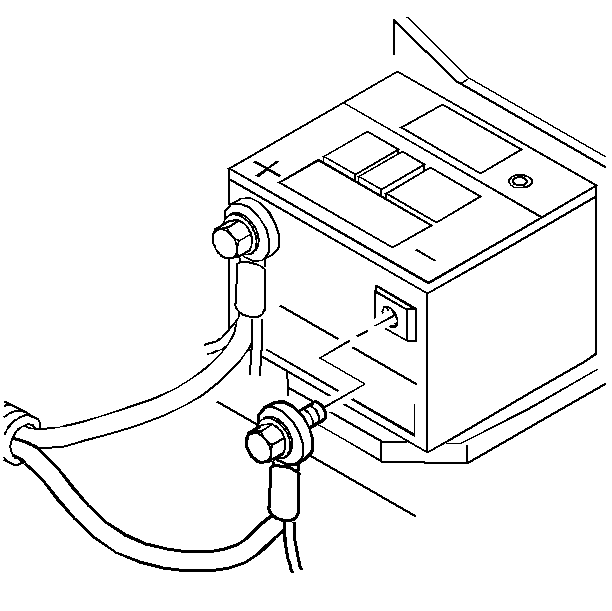
Caution: Unless directed otherwise, the ignition and start switch must be in the OFF or LOCK position, and all electrical loads must be OFF before servicing any electrical component. Disconnect the negative battery cable to prevent an electrical spark should a tool or equipment come in contact with an exposed electrical terminal. Failure to follow these precautions may result in personal injury and/or damage to the vehicle or its components.

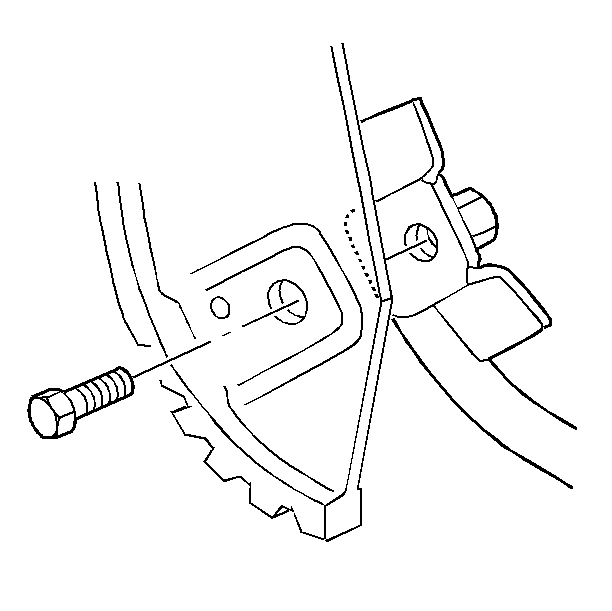
Important: 4.3L Engine: Remove the starter opening shield in the starter motor mounting port in order to access the torque converter to engine flywheel bolts.
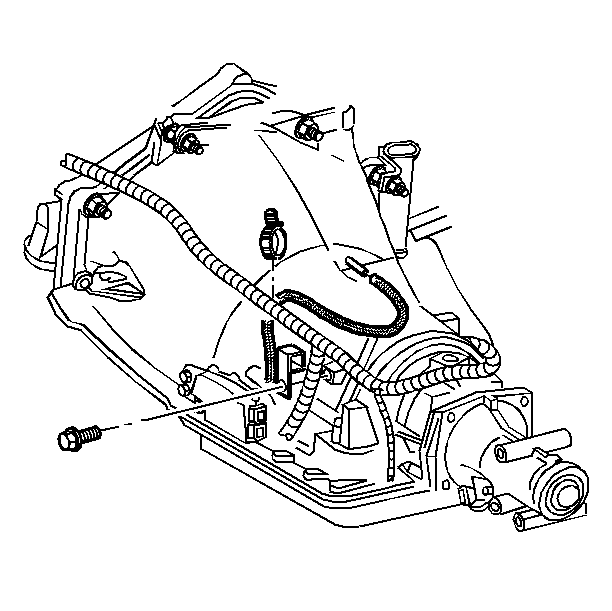
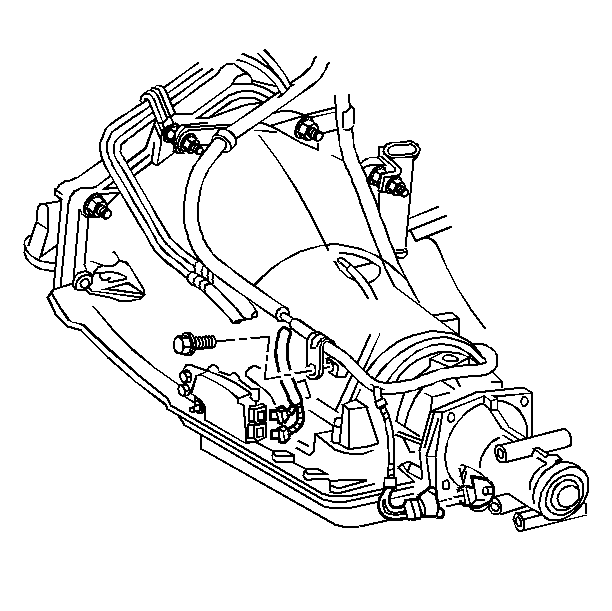
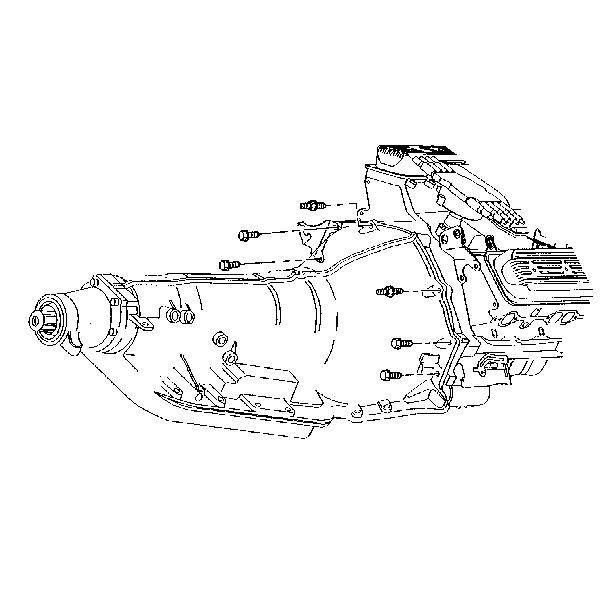
Installation Procedure
- Install the J 21366
- Support the transmission with a transmission jack.
- Raise the transmission into place and remove the J 21366 .
- Slide the transmission straight onto the locating pins while lining up the marks on the flywheel and the torque converter.
- Install the bolts that secure the transmission to the engine.
- Install the bolts securing the torque converter to the engine flywheel.
- First tighten all the bolts finger tight in order to insure proper converter seating.
- Tighten the bolts to 63 N·m (46 lb ft).
- Install the wiring harness connectors to the vehicle speed sensor and the park neutral position switch.
- Position and install all vehicle components that were removed or moved prior to the transmission removal, including the following:
- Remove the two plugs from the transmission case cooling line connectors.
- Install the transmission oil cooler pipes. Refer to Oil Cooler Hose/Pipe Replacement .
- Install the transmission fluid fill tube and the fill tube seal. Refer to Filler Tube Replacement (Passenger/Cargo Van) .
- Install the transmission vent hose and the wiring harness to the transmission. Refer to Vent Hose Replacement .
- Install the converter cover to the transmission if equipped.
- Install the starter motor. Refer to Starter Motor Replacement in Engine Electrical.
- Install the exhaust pipe to the exhaust manifolds and the muffler assembly to the exhaust pipe. Refer to appropriate procedures in Engine Exhaust.
- Install the rear transmission mount. Refer to Engine Mount Replacement in Engine Mechanical.
- Remove the transmission jack and the engine support stands.
- Install the rear propeller shaft. Refer to Propeller Shaft Replacement - One Piece or Propeller Shaft Replacement - Two Piece in Driveline/Axle.
- Install the transmission range select cable to the transmission range select lever and the bracket.
- Remove the safety stands.
- Lower the vehicle.
- Install new automatic transmission fluid. Refer to Fluid Capacity and to Automatic Transmission Fluid and Filter Replacement .
- Connect the battery negative cable assembly to the battery negative terminal.
Important:
• The torque converter must be flush onto the flywheel and rotate freely
by hand. • All the brackets, clips, and harnesses must be positioned in the same
position before removal. • Do not install the transmission fluid fill tube.

Tighten
Tighten the studs and the bolts to 47 N·m (34 lb ft).
Notice: Use the correct fastener in the correct location. Replacement fasteners must be the correct part number for that application. Fasteners requiring replacement or fasteners requiring the use of thread locking compound or sealant are identified in the service procedure. Do not use paints, lubricants, or corrosion inhibitors on fasteners or fastener joint surfaces unless specified. These coatings affect fastener torque and joint clamping force and may damage the fastener. Use the correct tightening sequence and specifications when installing fasteners in order to avoid damage to parts and systems.

Tighten

| • | The harness wires |
| • | The harness clips |
| • | The tubes |
| • | The brackets |
| • | The lines |

Notice: Use the correct fastener in the correct location. Replacement fasteners must be the correct part number for that application. Fasteners requiring replacement or fasteners requiring the use of thread locking compound or sealant are identified in the service procedure. Do not use paints, lubricants, or corrosion inhibitors on fasteners or fastener joint surfaces unless specified. These coatings affect fastener torque and joint clamping force and may damage the fastener. Use the correct tightening sequence and specifications when installing fasteners in order to avoid damage to parts and systems.
Tighten
Tighten bolts to 33 N·m (24 lb ft).

Tighten
Tighten the terminal bolt to 15 N·m (11 lb ft).
